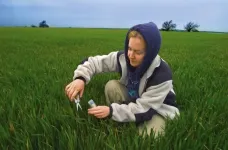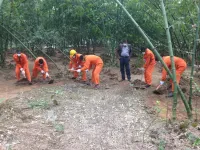(Press-News.org) CAMBRIDGE, MA -- One reason it's so difficult to produce effective vaccines against some viruses, including influenza and HIV, is that these viruses mutate very rapidly. This allows them to evade the antibodies generated by a particular vaccine, through a process known as "viral escape."
MIT researchers have now devised a new way to computationally model viral escape, based on models that were originally developed to analyze language. The model can predict which sections of viral surface proteins are more likely to mutate in a way that enables viral escape, and it can also identify sections that are less likely to mutate, making them good targets for new vaccines.
"Viral escape is a big problem," says Bonnie Berger, the Simons Professor of Mathematics and head of the Computation and Biology group in MIT's Computer Science and Artificial Intelligence Laboratory. "Viral escape of the surface protein of influenza and the envelope surface protein of HIV are both highly responsible for the fact that we don't have a universal flu vaccine, nor do we have a vaccine for HIV, both of which cause hundreds of thousands of deaths a year."
In a study appearing today in Science, Berger and her colleagues identified possible targets for vaccines against influenza, HIV, and SARS-CoV-2. Since that paper was accepted for publication, the researchers have also applied their model to the new variants of SARS-CoV-2 that recently emerged in the United Kingdom and South Africa. That analysis, which has not yet been peer-reviewed, flagged viral genetic sequences that should be further investigated for their potential to escape the existing vaccines, the researchers say.
Berger and Bryan Bryson, an assistant professor of biological engineering at MIT and a member of the Ragon Institute of MGH, MIT, and Harvard, are the senior authors of the paper, and the lead author is MIT graduate student Brian Hie.
The language of proteins
Different types of viruses acquire genetic mutations at different rates, and HIV and influenza are among those that mutate the fastest. For these mutations to promote viral escape, they must help the virus change the shape of its surface proteins so that antibodies can no longer bind to them. However, the protein can't change in a way that makes it nonfunctional.
The MIT team decided to model these criteria using a type of computational model known as a language model, from the field of natural language processing (NLP). These models were originally designed to analyze patterns in language, specifically, the frequency which with certain words occur together. The models can then make predictions of which words could be used to complete a sentence such as "Sally ate eggs for ..." The chosen word must be both grammatically correct and have the right meaning. In this example, an NLP model might predict "breakfast," or "lunch."
The researchers' key insight was that this kind of model could also be applied to biological information such as genetic sequences. In that case, grammar is analogous to the rules that determine whether the protein encoded by a particular sequence is functional or not, and semantic meaning is analogous to whether the protein can take on a new shape that helps it evade antibodies. Therefore, a mutation that enables viral escape must maintain the grammaticality of the sequence but change the protein's structure in a useful way.
"If a virus wants to escape the human immune system, it doesn't want to mutate itself so that it dies or can't replicate," Hie says. "It wants to preserve fitness but disguise itself enough so that it's undetectable by the human immune system."
To model this process, the researchers trained an NLP model to analyze patterns found in genetic sequences, which allows it to predict new sequences that have new functions but still follow the biological rules of protein structure. One significant advantage of this kind of modeling is that it requires only sequence information, which is much easier to obtain than protein structures. The model can be trained on a relatively small amount of information -- in this study, the researchers used 60,000 HIV sequences, 45,000 influenza sequences, and 4,000 coronavirus sequences.
"Language models are very powerful because they can learn this complex distributional structure and gain some insight into function just from sequence variation," Hie says. "We have this big corpus of viral sequence data for each amino acid position, and the model learns these properties of amino acid co-occurrence and co-variation across the training data."
Blocking escape
Once the model was trained, the researchers used it to predict sequences of the coronavirus spike protein, HIV envelope protein, and influenza hemagglutinin (HA) protein that would be more or less likely to generate escape mutations.
For influenza, the model revealed that the sequences least likely to mutate and produce viral escape were in the stalk of the HA protein. This is consistent with recent studies showing that antibodies that target the HA stalk (which most people infected with the flu or vaccinated against it do not develop) can offer near-universal protection against any flu strain.
The model's analysis of coronaviruses suggested that a part of the spike protein called the S2 subunit is least likely to generate escape mutations. The question still remains as to how rapidly the SARS-CoV-2 virus mutates, so it is unknown how long the vaccines now being deployed to combat the Covid-19 pandemic will remain effective. Initial evidence suggests that the virus does not mutate as rapidly as influenza or HIV. However, the researchers recently identified new mutations that have appeared in Singapore, South Africa, and Malaysia, that they believe should be investigated for potential viral escape (these new data are not yet peer-reviewed).
In their studies of HIV, the researchers found that the V1-V2 hypervariable region of the protein has many possible escape mutations, which is consistent with previous findings, and they also found sequences that would have a lower probability of escape.
The researchers are now working with others to use their model to identify possible targets for cancer vaccines that stimulate the body's own immune system to destroy tumors. They say it could also be used to design small-molecule drugs that might be less likely to provoke resistance, for diseases such as tuberculosis.
"There are so many opportunities, and the beautiful thing is all we need is sequence data, which is easy to produce," Bryson says.
INFORMATION:
The research was funded by a National Defense Science and Engineering Graduate Fellowship from the Department of Defense and a National Science Foundation Graduate Research Fellowship.
As the story goes, the Greek mathematician and tinkerer Archimedes came across an invention while traveling through ancient Egypt that would later bear his name. It was a machine consisting of a screw housed inside a hollow tube that trapped and drew water upon rotation. Now, researchers led by Stanford University physicist Benjamin Lev have developed a quantum version of Archimedes' screw that, instead of water, hauls fragile collections of gas atoms to higher and higher energy states without collapsing. Their discovery is detailed in a paper published Jan. 14 in Science.
"My expectation for ...
If you asked people which group of animals is the most abundant on earth, hardly anyone would know the right answer. Ants? Fish? No, and not humans either. The answer is nematodes, also known as roundworms. Four out of five animals on earth belong to this group, and the reason hardly anyone is aware of the fact is that they live underground, invisible to us. Together with thousands of other soil organisms, they quietly, discreetly and constantly perform enormously important services for the world above them.
The soil is one of the most species-rich habitats in existence. Living under one square meter ...
The human body is like a construction site where hundreds of thousands of different molecular nanomachines, called proteins, are simultaneously at work. Each one of these biomolecules, which are chains of amino acids essential to living organisms, perform a different biological function, often in synergy with other proteins. During their formation (the folding process) or in the performance of their biological functions, proteins change their shape in a very specific way. In many cases it is possible to conduct experiments that provide images of proteins at near atomic resolution, but only when they are in the stable and biologically ...
New research from CU Cancer Center member Jing Hong Wang, MD, PhD, and recent University of Colorado Immunology program graduate Rachel Woolaver, PhD, may help researchers develop more effective personalized immunotherapy for cancer patients.
Working within Wang's specialty of cancer immunology and head and neck squamous cell carcinomas (HNSCCs), the researchers worked to establish a mouse model that would help them understand why some hosts' immune systems reject tumors easily, while others have a harder time doing so. Their research was published last week in the Journal for ImmunoTherapy of Cancer.
"It's particularly interesting now because the field of cancer treatment has really been going in the direction of immunotherapy, ...
Researchers at the UC Davis Violence Prevention Research Program (VPRP) assessed the prevalence of exposure to violence, such as robbery or assault, and its impacts on the mental health and social functioning of California adults. Their study, published in the Journal of Interpersonal Violence, shows the far-reaching psychological effects an incident of gun violence can have on victims and those close to them.
The study's findings are based on data from 2,558 adults who responded to the 2018 California Safety and Wellbeing Survey (CSaWS). CSaWS is an ongoing survey research project on firearm ownership and the consequences of exposure to violence in California. Responses were weighted to be statistically representative of the state's adult population.
These ...
Primer on Carbon Dioxide Removal Provides Vital Resource at Critical Time
--By Julie Chao
Scientists say that any serious plan to address climate change should include carbon dioxide removal (CDR) technologies and policies, which makes the newly launched CDR Primer an especially vital resource, says Berkeley Lab scientist Margaret Torn, one of about three dozen scientists who contributed to this document.
"Atmospheric CO2 concentrations are already 50% over historic natural levels - 270 ppm (parts per million) in pre-industrial times vs 414 ppm today," said Torn. "To slow climate change and avoid its worst impacts, climate scientists tell ...
MADISON, Wis. -- As a new, apparently more transmissible version of the virus that causes COVID-19 has appeared in several countries, new research finds that the transmissibility of viral strains and the population density of a region will play big roles in how vaccination campaigns can help towns and cities return to more normal activities.
The findings suggest that directing vaccines toward densely populated counties would help to interrupt transmission of the disease. Current vaccination distribution plans don't take density into account.
Tony Ives at the University of Wisconsin-Madison and Claudio Bozzuto of the independent data research company Wildlife ...
Researchers from the University of Cambridge, the University of Milan and Google Research have used machine learning techniques to predict how proteins, particularly those implicated in neurological diseases, completely change their shapes in a matter of microseconds.
They found that when amyloid beta, a key protein implicated in Alzheimer's disease, adopts a highly disordered shape, it actually becomes less likely to stick together and form the toxic clusters which lead to the death of brain cells.
The results, reported in the journal Nature Computational Science, could aid in the future development of treatments ...
Decades after the industrialized world largely eliminated lead poisoning in children, the potent neurotoxin still lurks in one in three children globally. A new study in Bangladesh by researchers at Stanford University and other institutions finds that a relatively affordable remediation process can almost entirely remove lead left behind by unregulated battery recycling - an industry responsible for much of the lead soil contamination in poor and middle-income countries - and raises troubling questions about how to effectively eliminate the poison from children's bodies.
"Once the lead is in the environment, it stays there pretty much indefinitely ...
A new University of Saskatchewan (USask) study has found that stretching is superior to brisk walking for reducing blood pressure in people with high blood pressure or who are at risk of developing elevated blood pressure levels.
Walking has long been the prescription of choice for physicians trying to help their patients bring down their blood pressure. High blood pressure (hypertension) is a leading risk factor for cardiovascular disease and among the top preventable risk factors affecting overall mortality.
This new finding, published December 18, 2020 in the Journal of Physical Activity ...


